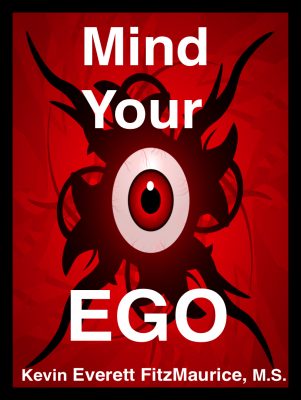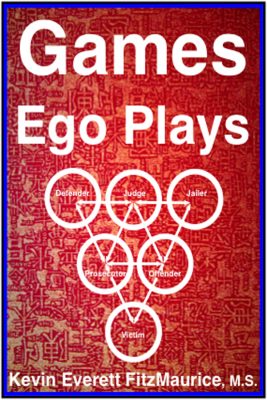DefenseMechanisms32 Table Version32 ExplainedMap of Human InteractionsRelated Pages6 Groups of Topics9 Skills & Topics
Kevin’s 32 Defense Mechanisms, Including Freud’s 12
- Ego will help you to recognize, remove, and replace your ego: a.k.a. self-esteem.
- Games Ego Plays diagrams and explains social interactions.
Defense mechanisms that protect the ego, pride, and self-esteem are covered. 32 are covered, including Freud’s 12.
“The worse deceit is self-deceit. “—David Ben-Gurion
“People have motives and thoughts of which they are not aware. “—Albert Ellis
“People have motives and thoughts of which they defend against being aware of.” —Kevin Everett FitzMaurice
- Read and discover the best system and plan to reduce and remove your ego.
Defense Mechanisms: What Do They Protect?
- The human ego, a.k.a. self-esteem, has two goals: (1) prevent becoming negative content; (2) work to become positive content.
- In other words, you want to look good and avoid looking bad.
- Alternatively, you want to have good self-concepts and self-images and avoid having bad self-concepts or self-images.
- This list informs you how much your ego needs to hide and lie about your negative content.
- While many items are similar, distinctions between them will help you catch the ego’s lies more often.
- Freud’s twelve defense mechanisms are added and rewritten at the end to be about the ego.
- Therefore, this list adds twenty more defenses to Freud’s original twelve.
Defense Mechanisms: Go to Table Tab for List
- This is a list of methods used to defend against awareness.
- The purpose of the methods is to hide negative mental content from consciousness.
- Internal darkness is currently referred to as the subconscious and unconscious minds.
- This is a study of self-deception in hiding from the light of consciousness.
- Ultimately, this list includes and repurposes Freud’s 12 Defense Mechanisms.
- Read and discover the best diagrams and maps of how people control and manipulate you.
- Defense mechanisms will be better understood when you read this book.
Table List of the 32 Defense Mechanisms
- Click to go to a page on Freud’s defense mechanisms.
- Read and discover the best diagrams and maps of how people control and manipulate you.
- Defense mechanisms will be better understood when you read this book.
Explanatory List of the 32 Defense Mechanisms
- This is a list of methods used to defend against awareness.
- The purpose of the methods is to hide negative mental content or material from consciousness.
- Internal darkness is currently referred to as the subconscious and unconscious minds.
- Ultimately, this list includes and repurposes Freud’s 12 Defense Mechanisms.
1. Escape Facing Negative Content
- You escape internal awareness of negative content by running away into activities, especially engaging ones.
- Escaping is running away when you come into contact with negative content.
- Addictions work well for this purpose.
2. Avoid Facing Negative Content
- You avoid internal awareness by keeping too busy to notice the negative content because your mind is on other things.
- Avoiding is not going near negative content in the first place.
- The workaholic addiction works well for this purpose.
3. Cover Negative Content with Appearances
- Change the appearance of negative internal events by covering them with ethics, ideals, morals, political slogans, or religious slogans.
- Just as clothes can hide unsightly skin, words can be used to hide negative content.
4. Reframe Away Negative Content
- Reframe anything negative until it is perceived as mild, neutral, or positive, not negative.
- In other words, you lie about the negative content and repeat the lies until the lies are mistaken for the negative content.
5. Try to Change Negative Content
- Pretend you are working on changing some negative even though nothing can ever be changed.
- While you can switch your focus regarding internal content, you cannot alter, change, or control any internal content or material.
6. Try to Conform to Negative Content
- Try to make some negative content conform to a higher standard even though it can never follow anything else not being a living entity.
7. Try to Control Negative Content
- Try to make some negative content act differently than it is, even though you cannot control anything to act like what it is not.
- You never succeed at control, but you do succeed at identifying with trying to control, and you believe that makes you good content.
8. Try to Convert, Convince, or Correct
- Try to convert, convince, or correct some negative into some opposite positive despite the impossibility of such. Success is not the goal. The goal is to appear better.
9. Compare Negative Content to Worse Content
- You compare the negative content to worse content to make your content look better than it is. “It’s really not so bad if you consider what others have done.”
10. Judge other Negative Content as Worse
- You judge other negative content as worse to make your content look better than it is.
- “This thinking is not the best, but at least I don’t want to kill my mother.”
11. Condemn Other Negative Content
- You condemn and criticize some other negative content so that you can focus on being the righteous judge instead of the perpetrator.
- “That is a totally rotten way to think, and I know better than to think like that.”
12. Demand Negative Content Not Exist
- Demand negative content does not exist while you eat and drink it for all its worth.
- This method is a form of no-ting.
- For more on no-ting read, Not a.k.a. Don’t Read This!
13. Feel Anger about Negative Content
- Get angry about negative content to distance yourself from responsibility for it.
- “Since I am angry about it, I am not it or the reason for it.”
14. Fight with Negative Conflict
- Be actively in conflict over the negative so that you can claim to side with the positive while you feed the negative.
- The more you fight with it, the more you feed it. “I am the righteous warrior.”
15. Suppress Negative Content
- You suppress negative content that you don’t want to look at but don’t deny.
- The difference between suppressing and repressing is that you still know that the negative content is there when you suppress it.
- When you repress, you lose all recognition of the negative content or material.
16. Blame Others or Life for Negative Content
- You try to prove the negative content is either not you or not yours by blaming others or life for its existence in you.
- How you can have it, and it can still not be yours, is not a question you care to consider.
17. Disown Negative Content
- You externalize the negative content as being outside of you instead of inside you. You do not deny the negative content.
- You believe it is in the world and not in you. Of course, even to talk about it requires it to be in you.
18. Whine about Negative Content
- You whine about the negative content to distance yourself from it and deny responsibility.
- “I am complaining about this content existing because somebody or something did this to me.”
19. Worry about Negative Content
- You worry about negative content to detach from it and deny responsibility.
- “I am worrying about it to prevent it magically. It is not me or from me.”
20. Feel Guilt or Shame about Negative Content
- You feel guilt or shame as a punishment for the negative content while permitting it to continue.
- “I am torturing myself for it, so obviously, I don’t want it.”
21. Focus on Positive Content (Freud’s Compensation Defense)
- You focus on and strengthen positive content to avoid and ignore negative content.
- For example, you talk and think about your good traits as if they were your only traits.
22. Deny Negative Content (Freud’s Denial Defense)
- You deny the existence of some negative content no matter how much evidence or history exists for that content.
- “I don’t see it; therefore, it is not there.”
- “My daughter could have never done such a thing even though she is pregnant.”
23. Switch Targets for Negative Content (Freud’s Displacement Defense)
- You want to throw mud at someone but dare not because of their position and power above you.
- Therefore, you throw the same mud at those who must take it from you because they are in lower positions than you.
24. Attach to Other’s Positive Content (Freud’s Identification Defense)
- You think poorly of yourself; to avoid this, you attach to some person, place, thing, or group you have positive content about.
- For example, you spend your time idolizing some movie or sports star.
25. Accept Others as Positive Content (Freud’s Introjection Defense)
- You uncritically accept some group or organization as providing only positive content so that you do not have to verify or face the possibility of negative content existing.
- “They are only good, so as part of them, I too am only good.”
26. Accuse Others of Negative Content (Freud’s Projection Defense)
- You see others as negative content you don’t want to see in yourself. You attack others for doing what you do.
- Politicians and social movement joiners make a career out of this.
27. Justify & Excuse Negative Content (Freud’s Rationalization Defense Mechanism)
- Your negative content is excusable or justifiable for reasons of your making, such as claiming victimhood.
- “I hate women because women abused me while I was growing up.”
28. Claim to Be Opposite Content (Freud’s Reaction Formation Defense Mechanism)
- Despite thinking and feeling one way, you present the opposite picture to the world to convince yourself that the negative content is not real.
- “I really love this company and job. I am so grateful to be working here (not).”
29. Nostalgia or Sentimental Content Switching (Freud’s Regression Defense Mechanism)
- You focus on an earlier period or development when you were happier to block out current problems or miseries.
- Perhaps you study a period you think was better and imagine yourself living then.
30. Force Negative Content into Darkness (Freud’s Repression Defense Mechanism)
- You put some content into a complete blackout without being seen or heard.
- You dig a deep hole and bury your problems as if that was not just giving them a license to operate undisturbed.
31. Penance for Negative Content (Freud’s Ritual and Undoing Defense Mechanism)
- You do the opposite of some negative content to make up for it, not end it.
- You punish yourself with tasks designed to make up for the negative content.
- Perhaps you feed the homeless while secretly despising them and maybe even causing them to be homeless.
32. Make Negative Content Work (Freud’s Sublimation Defense Mechanism)
- You might be a sadist who likes to hurt people, so you become a surgeon or a dentist who has a license to hurt people because their harm is called help.
- Perhaps you like to judge and damn people, so you become a judge so that you can claim exercising your hate is doing good for society.
- Read and discover the best diagrams and maps of how people control and manipulate you.
- Defense mechanisms will be better understood when you read this book.
Defense Mechanisms
MAP OF COMMUNICATION INTERACTIONS
- Games Ego Plays diagrams and explains social interactions.
- Diagram directly from the book of games people play.
- Read and discover the best diagrams and maps of how people control and manipulate you.
- Defense mechanisms will be better understood when you read this book.
Defense Mechanisms: Related Pages
- Communication Skills: Free Help
- Coping Skills: Free Help
- Counseling Issues: Free Help
- Counseling Issues: Freud’s 12 Defense Mechanisms
- Counseling Issues: Psychoanalysis—The Problems with Solutions
- Counseling Issues: REBT Is Deeper than CBT, CT, & other Counseling Theories
- Ego Issues: Payoffs for Ego
- Emotional Responsibility: List Pages
Save the Work of Carl Rogers
- Read and master the life skill of acceptance using the best combination of CBT, REBT, & Stoicism.
- Defense mechanisms are not needed when you master this book.
- Read and discover the best diagrams and maps of how people control and manipulate you.
- Defense mechanisms will be better understood when you read this book.
Defense Mechanisms: 6 Groups of Topics Menu
- 1. Pages by Topic
- 2. Fast-Facts by Topic
- 3. Quotations by Topic
- 4. Poems by Topic
- 5. Scripture by Topic
- 6. Websites by Topic
- Read and master the life skill of acceptance using the best combination of CBT, REBT, & Stoicism.
- Defense mechanisms are not needed when you master this book.
- Read and discover the best diagrams and maps of how people control and manipulate you.
- Defense mechanisms will be better understood when you read this book.
Defense Mechanisms: 9 Skills & Topics Menu
- 1. Anger Skills & Topics
- 2. Blame Skills & Topics
- 3. Communication Skills & Topics
- 4. Coping Skills & Topics
- 5. Counseling Skills & Topics
- 6. Praying Skills & Topics
- 7. Recovery Skills & Topics
- 8. Responsibility Skills & Topics
- 9. Thinking Skills & Topics
- Read and master the life skill of acceptance using the best combination of CBT, REBT, & Stoicism.
- Defense mechanisms are not needed when you master this book.
- Read and discover the best diagrams and maps of how people control and manipulate you.
- Defense mechanisms will be better understood when you read this book.






